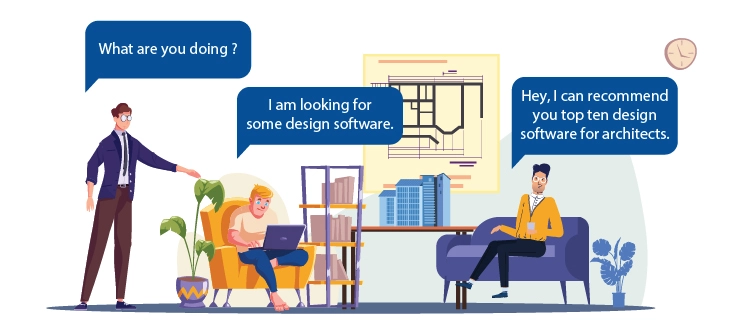 Shaheen M
Nov 28, 2024
Shaheen M
Nov 28, 2024

The best design software for architecture includes AutoCAD, Chief Architect, Civil 3D, Rhino, SketchUp, ArchiCAD, Cedreo, TurboCAD, Dynamo, and Photoshop. These tools are now essential for architects, providing advanced features that improve teamwork, visualization, and communication during the design process.
As per Global Market Insights,The architecture design software market was valued at $3.9 billion in 2023 and is expected to grow over 12% annually from 2024 to 2032. Modern design software allows architects to work more efficiently on shared projects, experiment with various design options in real-time, and effectively communicate their ideas to clients and stakeholders. These software solutions seamlessly integrate with Building Information Modeling (BIM) tools. With user-friendly interfaces they empower architects to manage complex projects effortlessly.
Following are the top 10 Design software for architecture,
AutoCAD is essential for architects as it offers a comprehensive suite of tools for drafting, designing, and documenting architectural plans with precision. Here are a few reasons why AutoCAD is important for architects:
Many people use AutoCAD as the first step in creating a 3D model. It allows you to create engineering drawings representing buildings at a more fundamental level. Designers often transfer these designs to other software packages to handle more advanced modeling concepts. Due to the popularity of AutoCAD, many different design packages are compatible with its files.
Furthermore, AutoCAD is a valuable educational tool. Users can change the settings and use them to learn the basics of design layers and line weights. Architects also have access to specific versions of the software within the industry. It allows you to draw the base model more efficiently. The AutoCAD course helps you gain proficiency in using the software’s tools and features
More houses are built than large office buildings and business parks. That is the talent of the Chief Architect. Homeowners, interior designers, housebuilders, and architects can use this tool to create unique houses considering remodeling.
According to your specific needs, a product selection begins very modestly, for example, on interiors. Or you can even spend more money to buy Premier products that manage all the details. Using Premier or Architect Interiors, you can quickly create 3D models of external and internal spaces and project them onto 2D floor plans and elevations.
Modeling and drawing are just two functions that builders and architects need in CAD. There are many other aspects, many of which are solved by Autodesk's Civil3D. Designed to work with other Autodesk products, most notably AutoCAD, Revit, and 3DS Max, it provides a Building Information Modeling's (BIM) workflow design and documentation pipeline. Top BIM software will have a more significant impact when engaged in large-scale construction projects.
Construction projects are almost incomplete without Autodesk Revit as there are several advantages of Revit in the civil structuring domain. With Revit Architecture Course, it is possible to create high-quality and precise engineering designs.
The Civil 3D course helps you develop skills in using the software's tools for design, analysis, and documentation of civil engineering projects. A helpful feature is integrating survey images with terrain models, service schematics, roads, and structural geometry. All these elements are found in a highly annotated package. Let engineers focus on one area and see how changes interfere with other sites.
Most CAD applications are suitable for straight lines but not for curves. From the beginning, Rhino's can handle very complex meshes, turns, and NURBS surfaces, such as human facial features and supercar curves.
For architectural design, Rhino can easily model complex intersections with curved roofs or any part of the structure that is non-linear. As a platform, it is not a unique tool. Instead, use add-ons and the Grasshopper visual planning system to customize specific tasks.
That makes Rhino a very flexible tool tuned to automate complex operations and complex modeling on projects that need them. CAD software is usually not required to upgrade to the next version, and the cost of the upgrade is usually only half that of the new license.
We firmly believe that architects must start the conceptual phase in 3D. SketchUp allows users to make 3D designs easily and quickly. The download is free, but many export features are disabled. Since Google bought the copyright, it has become trendy in terms of availability and cost. It is one of the easy-to-understand programs, but its simplicity also means limited rendering capabilities.
However, it is still a powerful program that conveys its original ideas and provides a vast library of components, mainly residential use. Each object, material, and surface has its texture, which is advantageous. So far, its most significant advantage is still its user-friendly interface.
The SketchUp course helps you develop skills in using the software’s tools for 3D modeling, design, and visualization of architectural projects.
Many people have proven that ArchiCAD provides everything a designer needs. Helpful in creating 2D and 3D models. You can also integrate many other software packages with ArchiCAD. The most common favorite is to insert V-Ray. It allows designers to create realistic models. Even people who have not integrated V-Ray into ArchiCAD can produce lifelike models. The new version of ArchiCAD includes CineRender for creating accurate models.
The primary function of ArchiCAD is its user-friendly features. You can learn the basics of the software effortlessly. It is popular with students and those who just started learning architecture. It provides a time-saving way to create detailed models. Therefore, it is ideal for time-critical projects.
Cedreo is 3D home design software for decorating professionals, home builders, and interior designers. A quick and easy solution will help you increase your sales. It only takes an hour to create a 3D floor plan and a realistic 3D render. Design your home plan by yourself. With Cedreo, you can start from a previous project, save it to your account and be ready to customize for a customer, saving valuable time by mastering all the early stages of the home draft.
Cedreo 3D rendering software is easy to use and powerful. In less than 5 minutes, you can create an accurate 3D rendering of the house with lighting and surface shadows from authentic images. That makes it easy to create compelling presentations to convey your vision and enable customers to visualize their new home faster than ever.
The latest version of TurboCAD provides professional software for experienced 2D and 3D CAD users. The architectural design suite contains parametric architectural objects, elevations, and sections, adding functionality to the mechanical and architectural areas of the program. Available on Windows and Mac operating systems, TurboCAD is called the "powerful alternative" to AutoCAD LT, and the setup wizard provides an easy transition for users switching between them.
TurboCAD prides itself on its realistic surface lighting and modeling, allowing you to create powerful presentations. Those who design with sheet metal or wood may particularly appreciate these material-specific tools. Internal and external database connections and file-sharing options, including file support from SketchUp, Autodesk, etc., allow teams to efficiently perform advanced integrations and collaborations.
Dynamo is usually provided as a free plug-in for use with Revit. However, there is also a standalone version of Dynamo. That means you must pay a subscription fee, but you can choose to use it separately from Revit. Dynamo is open source software, which means that there is a massive community around it, and they are constantly creating new features for the studio.
Dynamo is widely admired because it is one of the best geometry engines in any design package. That makes it easier to manage complex elements. In addition, you can successfully integrate the software into BIM workflows. Dynamo allows you to change your design quickly. Plus, you can customize the design on the fly. It will save you a lot of time. Otherwise, you will have to spend a lot of time editing the creation and saving it as a separate file. The software can also handle many file types. In this way, it can be used as a support tool for various other software. One of the most common use is to export Revit design information to a Microsoft Excel file.
Whether it is a section, plan, or elevation, it is essential to know how to use Photoshop when creating a rendering. It is a high-quality image creation software, very suitable for final rendering and retouching. Using the familiar layer system, you can give the atmosphere and style needed to render some adjustments and use for image processing, landscape, people, texture, sky addition, etc. It is also an excellent way to proofread and edit work scans to create illustrations for the final presentation.
The Photoshop course helps you develop skills in using the software’s tools for image editing, design, and visual enhancement, essential for architectural renderings and presentations.
Before making the final choice, there are a few things to check. You will have to ask yourself. What software do you need? Free architectural rendering software? Or architectural drawing software? 3D architecture software for Windows or Mac? You need to pay attention to your operating system before choosing a 3D program. It would be best to find out what is best for professional use. Do you want to use architecture software to help your design team collaborate or improve customer visualization?
Some software focuses on architectural visualization for good 3D rendering and visualization. There are also some free software or free trial software. Check out the various options and software available to the architect.
Each of the ten software in this article can help architects realize their vision. Which one is best for you depends on your needs. Generally, students and new designers tend to use SketchUp and ArchiCAD. Compared with other software, this software is more flexible and cheaper. Some people like more mature architecture software. Take the AutoCAD courses as an example; it has been the industry standard for many years and also very useful software and you'll certainly find it demanding in various fields of your career. Revit is in the same state. In addition, software such as Dynamo has proven to be effective for users who want to build a more comprehensive design package. The choice is up to you.

Shaheen is an expert Corporate Trainer in BIM, Architecture and CAD with over 8+ years of experience. His expertise includes advanced 3D BIM Modeling, Architectural Drafting and Detailing, and Interior & Visualization Design. Additionally, he offers tailored training programs specific to various industry needs. He has trained over 5,000 professionals in advanced modeling and design techniques.
Shaheen’s training expertise spans HVAC Design, Electrical Design, Tekla, Lumion, STAAD.Pro, AutoCAD 2D & 3D and Civil 3D. Through his hands-on teaching approach, Shaheen ensures that students engage with real-world architectural projects. His corporate training portfolio includes some of the top architectural companies in Dubai. He has trained professionals from universities, including Sharjah University, Ajman University and Canadian University, and companies such as KhanSaheb, HCTS, Silver Pool Technologies and many more. His practical industry experience enriches the training program's real-world value.